Click the image above for high-res gallery of the Autoblog Comparo: H2 vs. Landcruiser
The world's maddest battles usually earn a brief sobriquet: Red vs. Blue, Holyfield-Tyson, Lingerie Bowl. Although the battle we'll describe today isn't finished, the clash of HUMMER vs. Any Decent Off-roader – especially HUMMER vs. Jeep – has made so much noise on Autoblog alone that we decided it was time to investigate. Not having a Jeep at our disposal, we pitted an H2 against the Toyota Landcruiser on three trails in the California desert to find out if either of them had any quit – or if they'd keep going but complain about it. Follow the jump for the answer we came up with, and check out the gallery of off-road shenanigans below.
______________________________________________________
This post has been Twittered. Click here to follow Autoblog on Twitter
Quite a few folks out there don't believe that HUMMERs are fully capable off-road vehicles. Most of those who have actually driven HUMMERs off-road believe the opposite is true... and they often get called names because of that. We've owned an H2 that saw dirt once, driven the H3 and H3T, ridden shotgun in an H3 Alpha at the Baja 500, and pre-run the first section of the Baja course in an H2 modified with nothing other than bolt-on shocks. We've not only seen what HUMMERs can do, we did it. We're believers.
But just to make sure, we threw the H2 in with a venerable off-roader, the Toyota Landcruiser, on neutral ground. True, the U.S. Landcruiser isn't sold the same way, nor to the same crowd, it once was. But beneath the running boards and mudflaps and parking radar and leather interior and Lexus-like steering, it's the same truck that the U.N. still uses to lumber all over Middle-of-Nowhere-stan. That means: it's still one tough Beverly Hills pastry shop cookie.
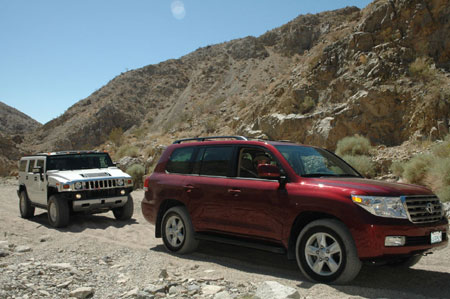
This was the brief: two trucks, two days, three trails. To ensure objectivity, our companions were a writer and a photographer from one of the major buff books, both experienced off-roaders and HUMMER-dissers. The photographer, on getting in the HUMMER, said "I can feel my sperm count rising. I think I should go impregnate my wife."
The point wasn't to put the trucks to the ultimate test. Besides the fact that there were time and safety limits, having to call Toyota and say "You can pick your truck up in Satan's Ditch, don't worry, it'll be there whenever you get to it..." is not the kind of thing that makes you friends with press fleet coordinators.
The point was to run the trucks over 4WD-required trails and see how they did. Although the Southern California desert offers a range of terrain, since neither truck is made for Rubicon lumbering or tight spaces we were dealing with mostly wide open tracks, albeit ones that offered a huge number of dips, ruts, rocks, sand, tight approach and departure angles, some serious sideways leaning, and a couple of giggle-inducing inclines.
We also ended up dealing with Nightmare Gulch, but we'll get to that in a moment.
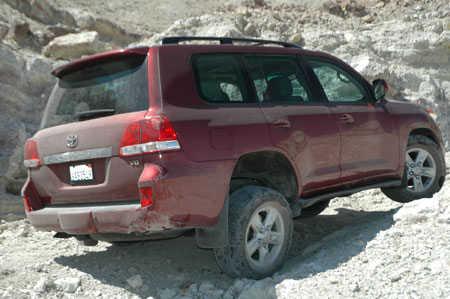
In one corner, we have the Toyota Landcruiser. Its 5.7-liter V8 puts out 381 hp and 401 lb-ft. through a 6-speed automatic. The scarlet steed rides on double wishbones with coil springs and a 43-mm stabilizer bar up front, and a 4-link suspension with coil springs and a 25-mm stabilizer bar out back. The total package comes in at a gross vehicle weight of 7,257 pounds.
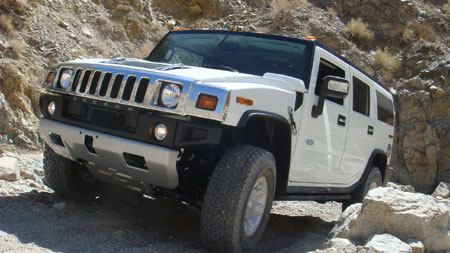
The H2 uses a 6.2-liter V8 with 393 hp and 415 lb-ft. running through a 6-speed automatic. It gets an independent front suspension with torsion bars, monotube gas shocks and a 36-mm stabilizer bar up front, while the backside gets a 5-link suspension with self-leveling air springs, monotube gas shocks, and a 32-mm stabilizer bar. Gross vehicle weight: 8,600 pounds.
The first major difference between the trucks were the tires: the H2 came with 315/70 R17 all-terrain rubber. The Landcruiser, luxury boat that it is, came with 285/60 R18 mud-and-snow rated tires. Though it might not look like an equitable challenge, surprisingly, the tires really weren't a factor.
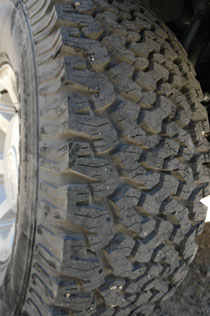
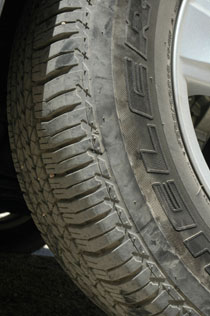
The other major difference was the Get Out of Trouble mode each truck employed. In fact, the whole thing came down to a battle of two dials: the locking rear diff dial in the H2 and the crawl dial in the Landcruiser. The H2's central and rear lockers combine to get all the power down on the ground that they can in order to get the truck unstuck. The Landcruiser's system uses the brakes in a way akin to ABS, but this time they prevent wheelspin, not wheel lock. Instead of feeling the pedal's dull thud as you do when ABS kicks in, you hear the brakes rapid-fire clamp-and-disengage. It sounds like a giant spring has been given a tremendous whack and is flopping back into position. Or like the truck is about to break in half.
But it works, and it got the Landcruiser out of every tender position we put it in. In fact, you could turn the dial – it has three speed settings – and let the truck do all the work. All you need to do is stay alive. And steer.
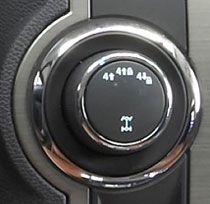
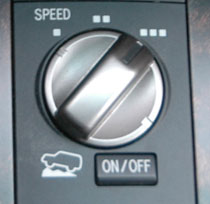
The three trails we covered are in the El Paso Mountains of Red Rock State Park: Last Chance Canyon at 10.6 miles with a Difficulty Rating (DR) of 5, Cudahy Camp at 7.2 miles with a DR of 4, and Opal Canyon Road at 6.3 miles with a DR of 5.
The first section of Last Chance Canyon is soft sand and gravel. Neither truck liked it, but if you were judicious with your lines and able to hold your speed, you made good time. If you stopped, you got your first lesson in the two trucks' different throttle responses. The H2's throttle has an even, steady progression and a comfortable measure of travel between wheels stopped and wheels turning. You knew when the power was about to be laid down, and there was even enough pedal movement to accurately modulate wheelspin.
The Landcruiser accelerator, in 4W High, was binary – sitting in the sand at a stop, slowly depressing the accelerator would result in churning rubber and flying sand. Nothing in between. That's apparently the "Road" setting. But put the truck in 4W Low and the throttle response is much more elastic, giving you more control over the power. All you have to do is then remember to put the 'Cruiser back in 4W High when you're up to speed again.
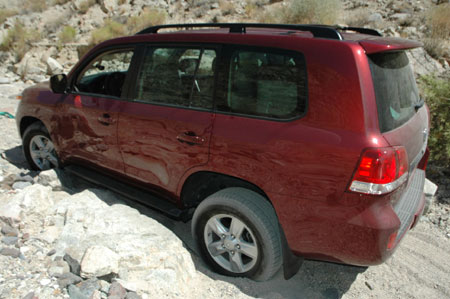
That sand also gave us a first test of the 'Cruiser's crawl system. Coming around a slow corner, the scarlet pimpernel bogged itself when the back wheels dug into the sand – in 4W High – after traversing some rocks. Coming up behind in the H2, we put the great white hope into 4W Low and took a different line through a run of boulders. Before we figured out what to do with the 'Cruiser, one of our companions said of the H2, "It really is the off-roader for idiots. You can just point it somewhere and run over things."
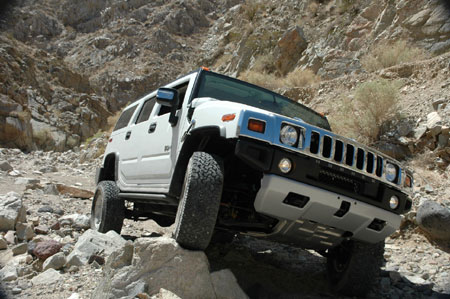
But he didn't mean it as a compliment. It was then we realized this is simply how it was going to be with the HUMMER. It does everything you want it to, but instead of "capable," it's "the off-roader for idiots."
We put the 'Cruiser into crawl mode, listened to the rapidfire springing action of the brakes, and what do you know, the truck pulled itself out of the mire. Contrary to how it might sound, the 'Cruiser doesn't lurch while this is happening – it's all quite steady, like riding a horse as it picks its way up a rocky slope. Again, all you have to do is not fall off. It's electronics vs. mechanicals in this case, and assuming the electrics don't go fritzing, it's cheaper, lighter, and less expensive than putting a differential back there to achieve the same effect.
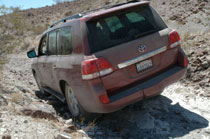
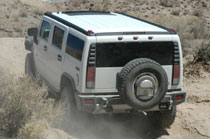
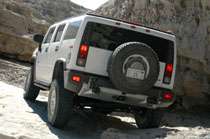
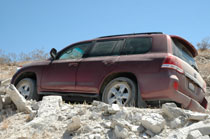
This would be the experience for most of the two days: H2 grunt vs. the Landcruiser softshoe. Because the 'Cruiser is really sold for road duty, the running boards took a beating on the rocks (sorry, Toyota), and the smaller tires meant traversing ruts and obstacles was an affair requiring constant attention and finesse that we mostly managed to pull off without incident – key word being "mostly" (again, sorry, Toyota). The 'Cruiser's approach and departure angles are almost a full ten degrees less than the H2's. But the 'Cruiser is still the badass dirt runner that it was created to be.
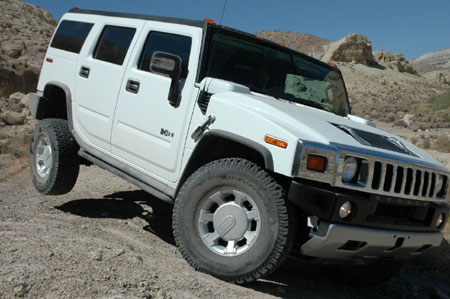
Proof of such came at one point on Opal Canyon Road, when the trail made a dropoff 90-degree left turn. The H2's rear right wheel came a fair ways off the ground, but the 'Cruiser – making the same turn a couple of times, just to make sure – with its solid rear axle and Panhard rod, lifted up only a couple of inches. Although it doesn't look like it, the travel is immense, and the vehicle is stupendously sure-footed.
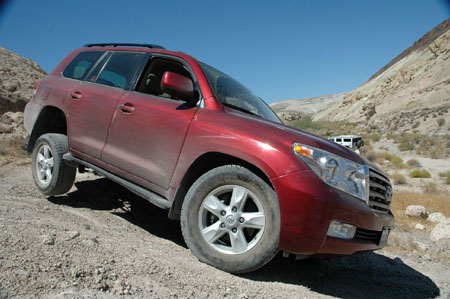
On the cliff-like incline facing that descending turn, yet another demonstration occured of how the two vehicles deal with nature. Throw the H2 into 4W Low and listen to the V8 rumble as it clobbers the hill. Throw the 'Cruiser into crawl and listen to Puccini while pretending you're Don Quixote atop Rocinante. Everybody wins.
But remember, we did say that this was the experience for most of the two days. We went a gulch too far at the end, winding up in a zig-zagging wash right out of a The Good, the Bad, and the Ugly. Only this wasn't merely ugly, it was hideous, gorgon-like. We would find out later that we were in Nightmare Gulch.
The Gulch is nothing but rocks, was probably carved out by a god made of rocks, and meant as a natural limestone and granite womb that would give birth to new families of rocks every few hours. And the entire thing is coated with sand. It's like Disneyland. If Disneyland were made of rocks. And coated with sand.
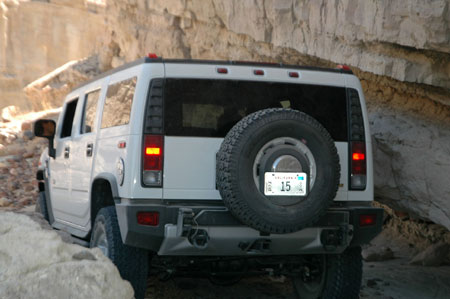
It was the kind of thing we meant to avoid, but since we were there, and the trail's end was just one sweet mile-and-a-half through the maze, we tried it. And yes, we came face-to-face – or rather, body-panel-to-rock-wall, with the full-sized SUVs' kryptonite: skinny places.
The H2's castle-like girth makes it ill equipped for a slot like Nightmare Gulch. But frankly, before you call out the H2, Nightmare Gulch is a place you couldn't take a lot of vehicles: none of the multi-shocked high-rise 4x4s with NASA light arrays could have made it; any stock crew-cab long bed would have suffered a couple of scrapes at the very least; even the Landcruiser took a beating. Yes, you could take a Wrangler Rubicon with little problem, but only because it's smaller.
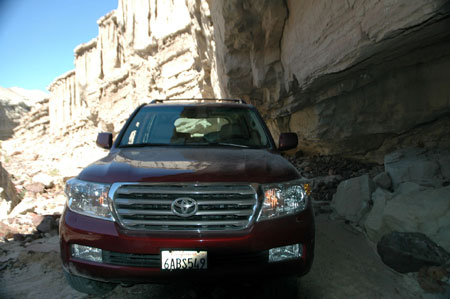
The H2 and the Landcruiser tip-toed through it admirably, both drivers scrupulously following the spotter's directions. But the rocks would not be mocked, and they certainly weren't going to allow these leviathans to pass without paying a paint and metal tax.
One slippery turn was our undoing. Coming to a bottleneck formed by the gulch wall and a massive boulder, the left side of the H2 rose up over a couple of boulders half buried in the trail... and then the truck slid into the wall. Try as we might, the sand and gravity said "We'll take it from here," and every time we got a bit of clearance the great white whale would slide again when we tried to move it (sorry, HUMMER...).
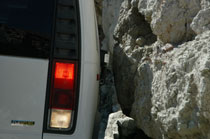
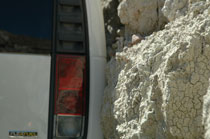
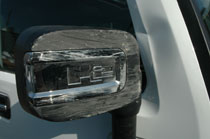
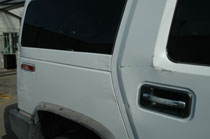
After a couple of hours of digging and hammering and tow-strap-earthmoving in Mercury-like heat, just a half mile from the trail end, we gave up, backed the truck up off the wall – it wasn't pretty – and backed both trucks out of the gulch, then turned around and fled for the closest thing to civilization, which was Denny's.
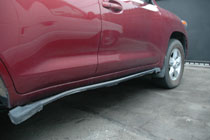
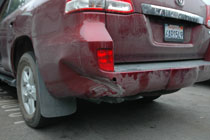
In this blogger's version of the debrief after a Moons Over My Hammy, the finding was that the H2 and the Landcruiser will go anywhere you point them. Period. Anyone who says otherwise is, quite simply, incorrect. The only difference is in how they do it. The H2 is a thoroughly mechanical machine that overcomes obstacles with locking diffs and brute force. The Landcruiser substitutes some of that rawness with an electronic aid that will achieve the same end. The only thing we would change on the Landcruiser for off-road work is the steering: it really is Lexus-light, no matter what you're doing. Unless the wheels were positively stuck, you could always turn the wheel with two fingers. But we would take either truck anywhere.
Well, anywhere they could fit.
Still, the co-drivers would not be swayed. "The H2 is still absurd," they said, "but it had the right tires, and that's what this is really all about." The H2 could not get a fair trial; it had just done everything we wanted it to do, but now it was only because of the tires. We rebutted: Hogwash. The H2 covered every trail and had plenty left over, and that's what this was really all about.
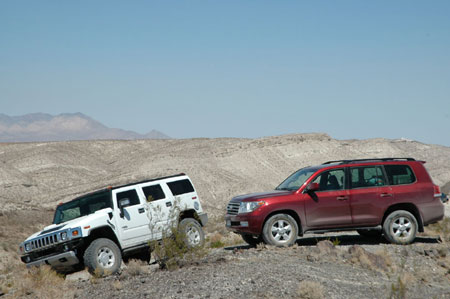
It was in the parking lot afterward that the smackdown came. We were walking to the H2, about to enjoy the long drive home, when we heard: "The Jeep Rubicon is really the best off-roader out there because it's got locking front and rear diffs and 33-inch tires." We turned and said "So does the H3T."
They looked at your humble Autoblogger like you look at a fish floating oddly at the top of the tank – "Is he dead or just kind of messed up?" Speaking like they wanted me to read their lips in case my primitive brain weren't developed enough to process their language sounds, they asked, "Are you saying you want to do it?"
"Oh yeah."
Stay tuned next month for Rubicon vs. H3T on a 7-rated, 23.6 mile monstrosity of a trail. The battle rages.


Sign in to post
Please sign in to leave a comment.
Continue